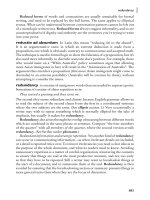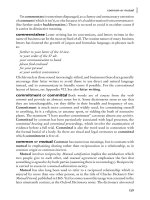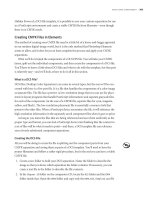the nordstrom way to Customer Service Excellence phần 9 doc
Bạn đang xem bản rút gọn của tài liệu. Xem và tải ngay bản đầy đủ của tài liệu tại đây (165.59 KB, 28 trang )
Sell the Relationship
207
3. Think the project (problem) through.
4. Ask yourself: “If I were the client, would I pay for this?”
5. Don’t give reasons why it can’t be done. Tell how it can be
done and the consequences.
6. Don’t wait to do it if it can be done now.
7. Service the client not the project.
8. You don’t know if you don’t ask.
9. Start a conversation with one new person every day.
10. Sketch ideas being discussed in front of the client. Always
bring tracing paper and scale.
“With companies that we’ve had long-term relationships
with, we have to constantly reinvent ourselves so that we don’t
become lazy and give them what we’ve always given them. It’s
a constant challenge. It’s easier to grab a new client and wow
them. The work begins after a few years when they are think-
ing, oh, we’ve been with these guys,” said M. J. Munsell, a prin-
cipal in Callison. “There are a lot of people knocking on our
clients’ doors. We have to remind ourselves every day that we
are in constant competition with those other firms.”
To guard against this complacency, Callison has tried several
approaches. “One way might mean introducing new people in the
firm to the client or providing the client with new services or a
new product that they are not expecting from us,” said Munsell.
“It might mean changing the way we present to the client. That’s
how we invigorate our staff. We tell them: ‘Don’t just give us the
same old thing. What can you do new for this client today that you
didn’t do for them yesterday?’ By tackling this problem, we can
have creative fun and do new things in the process.”
Another way to keep things fresh is to be a source for new
ideas and approaches. Callison devotes a lot of time and energy
into researching the industries of their clients and trying to fig
ure
WHAT EMPLOYEES CAN DO
208
Keys to Success
Relationships are the essence of customer service. If what you are
selling is similar to what your competitor is selling, and if your
prices are similar to your competitor’s prices, how can you get an
edge? By developing a strong relationship with your customer—
and by never taking that relationship for granted. Customers are
looking for people who take responsibility for their actions. Those
customers can be very forgiving if they see that you hear the prob-
lem and you take care of the problem.
Ⅲ Listen to the customer.
Ⅲ Understand the customer’s needs.
Ⅲ Emphasize knowledge of your products and services.
Ⅲ Be honest and sincere.
Ⅲ Track your sphere of influence.
Ⅲ A referral that comes from a satisfied client is a lot easier to
get than new business from a stranger.
Ⅲ Create a lifetime experience.
Ⅲ Develop a positive working relationship with your vendors
and suppliers.
Ⅲ Service the client not the project.
Ⅲ Become a source for new ideas.
Ⅲ Take responsibility.
out where those industries are going. Just as Nordstrom sales-
people maintain relationships with their customers by sending
them thank-you notes after a sale, Callison employees will clip out
articles on subjects they think their client would be interested in.
Sell the Relationship
209
EXERCISE
Measuring Both Feet
How do you develop a relationship with your customers?
Ⅲ Gather a cross section of your colleagues for a brainstorming
session on how you develop the relationship.
Ⅲ Prepare a list of questions that you ask your customers.
Ⅲ Distribute this list to everyone in your organization.
Ⅲ Ask them to add to this list.
Ⅲ Make this list of questions a standard feature in your
training.
EXERCISE
Tracking Spheres of Inf luence
How did you get that client?
Ⅲ Make a list of your longest standing customers.
Ⅲ Ask them what’s keeping them with your company.
Ⅲ Devise ways to reward those clients for their loyalty.
Ⅲ Follow through by rewarding them for their loyalty.
WHAT EMPLOYEES CAN DO
210
EXERCISE
Rewarding Vendors and Suppliers
Ⅲ Make a list of your best vendors and suppliers.
Ⅲ Devise ways to reward them for their loyalty.
Ⅲ Emulating Nordstrom’s “Partners in Excellence,” create an
official program to reward your vendors and suppliers.
211
The Sale Is Never Over
Secrets of Nordstrom’s All-Time
Top-Performing Salesperson
A salesman minus enthusiasm is just a clerk.
—Harry F. Banks
11
213
B
efore he retired in 2001, Patrick McCarthy was Nord-
strom’s all-time top salesman, after a 30-year career with
the company. For 15 consecutive years, the native of Seattle was
the Number One salesman throughout the entire chain.
McCarthy had arrived at Nordstrom from an unlikely
place—the state prison in Shelton, Washington, a timber com-
munity 60 miles south of Seattle, where he worked as a counselor
for felons. The first couple of years at Shelton, he helped adult
criminals make the transition to the community by placing them
in jobs; after that, he became supervisor of a halfway house for
juveniles, counseling them to stay in school or find employment,
rather than remain dependent on the state. The work was frus-
trating and mentally draining.
“I’ve always believed in hard work, but in that environment,
it just wasn’t there,” recalled McCarthy. “You couldn’t get the
kid to listen, to understand that you can make something of your
life. As much as I wanted to help, I couldn’t.”
A college friend set up an interview for McCarthy with the
friend’s father-in-law, Lloyd Nordstrom, one of the three co-
chairmen of what was then a seven-store retail chain that gen-
erated annual sales of about $80 million, as well as hundreds of
new career advancement opportunities. Lloyd Nordstrom ad-
vised McCarthy to try a career in sales, a field that McCarthy
WHAT EMPLOYEES CAN DO
214
thought he “might have an aptitude for, because I had always
been comfortable with people and sensitive to their feelings.”
In January 1971, at the age of 26, with a wife and three
young children to support, he joined the men’s furnishings and
sportswear departments at the store in the Bellevue Square shop-
ping mall, across Lake Washington from Seattle. (At that point,
Nordstrom had been selling men’s wear for only three years.)
Nordstrom, then as now, provided little in the way of formal
sales training. After teaching new employees how the cash reg-
ister worked, Nordstrom dispatched them to the sales f loor to
learn about the merchandise and start selling. Although they were
paid an hourly wage, the real money (and the scorecard for ca-
reer advancement) was in high sales commissions.
“I immediately saw that sales were pretty important to these
guys. So, that was what I was going to give them,” McCarthy re-
called, with a touch of understatement.
Unfortunately, he was ill prepared for the job.
“I made every mistake in the book. Although I liked to dress
well, I knew virtually nothing about clothing and had no per-
sonal style. I wore my shirts too big. I didn’t know how to fold
garments for display or to coordinate colors and textures. Worse,
because I had some learning disabilities, including dyslexia, my
work habits and organizational skills were poor. I couldn’t even
get to work on time.”
After three days on the job, McCarthy’s sales per-hour track
record (the company’s standard of performance) was near the
bottom of his department.
McCarthy realized that he needed a mentor to teach him
how to survive at Nordstrom. He found his role model in a
coworker named Ray Black, who was a professional men’s
wear salesman, who showed McCarthy how to work with the
The Sale Is Never Over
215
customer. (Black’s influence as McCarthy’s mentor is explained
in detail in Chapter 8.)
Becoming a Team Player.
After working at Nordstrom for less than two years, McCarthy
came within a thread of being fired because he had developed a
reputation for being uncooperative, hard to manage, and not a
team player.
McCarthy often found himself discouraged and stuck in what
he called a “poor me” attitude. “I’d ask myself, ‘Why am I doing
all this? Am I making a difference?’ ” Fortunately, the new men’s
wear department manager, who had been ordered to terminate
McCarthy, didn’t believe in dropping the ax without first form-
ing his own opinion. Besides, he’d been told that McCarthy was
a sincere man, who was open and friendly with customers and
possessed the potential to be a good Nordstrom sales associate.
That department manager, Patrick Kennedy, told McCarthy
to stop fighting with coworkers over customers—even at those
times when McCarthy was positive that the customer was his.
“Ring up the sale for the other guy,” said Kennedy, “and smile
when you do it.”
Then he gave McCarthy some of the most important advice
a sales associate can get, advice that McCarthy carried with him
ever since, advice that he later gave as a mentor to new employ-
ees: “Relax. Stop worrying about making sales.”
Easier said than done, thought McCarthy, in the hotly com-
petitive Nordstrom arena of commission sales. But, Kennedy ex-
plained, when you stop worrying about money and concentrate
on serving the customer, the money will follow. People who suc-
ceed in sales understand this paradox.
WHAT EMPLOYEES CAN DO
216
McCarthy followed Kennedy’s advice, and he was able to
hone his sales skills. Six months after almost firing McCarthy,
Kennedy (who became one of Nordstrom’s top corporate
footwear merchandisers, and one of McCarthy’s best friends),
invited McCarthy to become his assistant manager in the men’s
wear department in a new store that Nordstrom was opening in
Yakima, Washington, about 120 miles east of Seattle. McCarthy
accepted the offer because it was an opportunity to help create an
operation and watch it grow. (Nordstrom had already been op-
erating a shoe store there for several years.) Yakima, which had
a small middle-class population (then Nordstrom’s primary mar-
ket), would be his litmus test.
Business was good on the Friday the Yakima store opened
and continued at a respectable pace throughout the rest of the
weekend, but by Monday the customers had stopped coming in.
“At the end of the day, Pat Kennedy and I found ourselves
leaning on the balcony overlooking the selling f loor, watching
the cosmetic saleswomen put their merchandise away and won-
dering what we were going to do,” McCarthy recalled. “We
each had a family to support, and Nordstrom didn’t pay us much
in those days.”
They took matters into their own hands. To generate traffic,
McCarthy and Kennedy turned to one of the most basic tools
for generating sales: cold calls. The two Pats and their wives,
Gretchen McCarthy and Judy Kennedy, each seized a telephone
book and a telephone and proceeded to call the local doctors, at-
torneys, automobile dealers, bank presidents, and anyone else
who might be in the market for a nice suit.
“Whenever we got a positive reception, we sprang into ac-
tion,” said McCarthy. “Whatever our customers wanted, we
obliged. We met them at their office for special fittings. We
The Sale Is Never Over
217
visited their homes to help them take an inventory of their
wardrobe. We told them what to keep and what to discard. Their
wives were so appreciative, they would tell us, ‘I’ve been trying
to tell him to get rid of that double-knit suit for five years.’ We’d
start them out with the basics—traditional gray flannel suit and
navy blazer, a couple of white shirts, a couple of blue shirts, and
maybe a pinstripe. We’d finish off the wardrobe with rep ties, ar-
gyle socks, a reversible belt, and a pair of tassel loafers.”
Becoming a Super Salesperson.
His Yakima experience represented McCarthy’s first real steps
toward becoming a super salesperson. He began developing his
first personal customer book. As we described in Chapter 10,
one of the most valuable tools that Nordstrom gives its salespeo-
ple is the personal customer book, which helps them keep track
of every customer’s name, telephone number, charge account
number, sizes, previous purchases, vendor preferences, likes and
dislikes, special orders, and any other characteristics, such as being
a difficult fit or preferring to shop during sales events. They also
contain daily, weekly, and monthly calendars, a to-do list, and the
phone extension for every department in every Nordstrom store
in the country.
The personal books used to be expandable, loose-leaf per-
sonal books; today, they are a software program designed for use
on a personal computer.
Using his personal book, McCarthy developed the habit of
calling specific customers whenever special merchandise came
into the store. When birthdays or anniversaries were coming up,
he phoned his customers’ wives or children with potential gift
suggestions.
WHAT EMPLOYEES CAN DO
218
“Finding My Bliss”.
After four months in Yakima, McCarthy tried his hand at being
a department manager in another Nordstrom store. But after
aboutayearandahalf,hediscoveredthatmanagementwasn’tfor
him because it took him away from sales, while sales took him
away from managing. He decided to devote himself exclusively
to sales, although, initially, the decision was a blow to his ego
because a part of him still coveted the status and cachet of the
title of department manager. “And after all, doesn’t society teach
us that management is the ultimate goal?” McCarthy said rhetor-
ically. “To be ‘just a salesperson’ doesn’t sound quite enough,
does it? But it was for me. The farther I got away from my man-
agement responsibilities, the more I realized that I made the right
decision. Sales was what I was good at and felt comfortable with.
I was, in the words of the philosopher Joseph Campbell, ‘finding
my bliss.’”
But even when he reached a point where he felt comfortable
as “just a salesperson,” McCarthy’s sales-education process had
barely begun. Despite his extensive experience and the lessons
he had learned, it wasn’t until he had worked for Nordstrom for
seven years that, in his own assessment, his skills “finally came
together and my business really started to take off.”
McCarthy carried on the tradition of his mentor, Ray Black.
Not only was McCarthy famous for his ability to remember
names, sizes, and preferences, but also for his empathy, because
sometimes his professional relationships with customers can prog-
ress to the profoundly personal. McCarthy, who lost his thir
teen-
year-old son in a fatal accident, is a sympathetic listener, whether
counseling a customer whose child needed help kicking a drug
habit or advising another customer on what to do with his life
The Sale Is Never Over
219
after retirement. “This job is more than selling clothes,” he said.
“It’s important for me to give back to the bucket of life.”
Among successful Nordstrom people, such a self less attitude
is more the rule than the exception.
Creating a System.
You will have noticed that at Nordstrom the priority is on sell-
ing. But the key to selling is providing outstanding customer ser-
vice. Nordstrom’s best associates have learned how not to “walk”
a customer—that is, not to lose a sale because they couldn’t sat-
isfy what the customer wanted. That knowledge comes from
practice, experience, and a professional commitment.
As his career grew, McCarthy built his business on referrals.
That made it even more essential for him to record all customers’
purchases in his personal book because he serviced so many
downtown Seattle businessmen. At one point, his client list in-
cluded 40 lawyers in a downtown Seattle f irm of 150 lawyers.
“I had to make sure that two men who work in the same of-
fice, or who were likely to run into each other, weren’t wearing
the same outfit,” he said. “You can have as many customers as
you want, but you have to take care of each one on an individ-
ual basis. Ninety percent of your new clients come from refer-
rals from current clients who appreciate the job you have done.
I didn’t want to disappoint them by giving bad service.”
McCarthy recommends that a new sales associate begin to
develop his or her customer service style by starting with the ba-
sics: organize and build a system, believe in it, and then execute
it. “It’s more than thinking positive,” said McCarthy. “Posi-
tive thinking comes from following simple steps that produce
results.”
WHAT EMPLOYEES CAN DO
220
Starting the Work Day.
He compared his personal system of customer service to a car en-
gine, whose parts can be taken apart and reassembled.
“I worked hard at not having to look like I was working hard.
That came from constantly thinking and planning. I kept on im-
proving as a salesperson because I kept on learning better ways to
service the customer. When Larry Bird played basketball, he
looked so natural, you would think he must have always played
with such skill and confidence. But Larry Bird was once clumsy;
he had to work hard to make his play look natural. Larry Bird
‘saw’ the basketball f loor; I ‘saw’ the sales floor.”
McCarthy’s preparation for the sales day started virtually
with his initial waking thought.
“First put yourself in the right frame of mind. I would look
in the mirror and say, ‘Okay, Pat, what do you need to do
today? Why are you going to work today, and what do you hope
to gain?’”
He would arrive at work early to make sure pickups were
ready for a customer’s arrival. So, when the customer came into
the store, McCarthy would not waste time “fumbling around”
looking for the customer’s purchase.
He used the extra time before the store opened to tackle
the most difficult tasks first, so they weren’t hanging over his
head all day.
“Don’t put things off until the end of the day when you’re
ready to leave. If I had to call a customer because something
wasn’t done right, I’d get it out of the way. By doing so, I could
start the day fresh and the customer got the sense that Nordstrom
values and cares for its customers. I was not only building Nord-
strom’s business, I was building my business and my relationship
with that customer.”
The Sale Is Never Over
221
Once McCarthy arrived in his department at the downtown
Seattle store, he was completely focused on the chores of the day.
He usually skipped lunch and took no breaks. He always had sev-
eral projects in progress because “when I was in motion, I was
much more creative and opportunities were constantly opening
up for me. I visualized my tasks completed. I was continually
writing notes, and reviewing the things I had to do for the day,
and double-checking to make sure they got done. One list, for
example, might consist of things to get done in the tailor shop;
another list consists of people to call. Everywhere I turned, there
was something being accomplished. I didn’t leave things to
chance. Things that I planned a week or a month ago were being
taken care of. I wanted to do them right the first time so that I
would be free to move on to the next task.”
At the end of the day, McCarthy, like many associates wrote his
thank-you notes so he could start the next day with a clean slate.
“I hated to start up first thing in the morning, so I liked to
make sure that there was nothing left to be done at the end of the
day,” said McCarthy. “Whatever wasn’t done was the first item
on my list for the next day. Before I went on vacation, I set it up
so that I was busy the first week I return. It was like I never left.”
Telephone Skills.
During the course of his day, he would make about 40 calls to
customers. In March, he made calls to alert people to what is
coming in for spring. In August, he talked about clothes that
would be coming into the store in the fall.
“How to use the telephone and how not to is so important,
yet so misunderstood,” said McCarthy. “Listen to what your
client is asking. Avoid sounding preoccupied; sound like you are
WHAT EMPLOYEES CAN DO
222
devoted to your job and are at the service to the customer. Give
him a warm hello—even if you don’t feel it. If you are short with
him, you are sending the wrong message. It’s okay to acknowl-
edge that you are human: ‘I’ve had a terrible morning. Let me
get some business out of the way and I’ll call you back so that I
can devote my full attention to you.’ ”
McCarthy found that his phone calls provided him with valu-
able information.
“I saw economic recessions coming six months before the
economists did because I could hear it in my customers’ voices
and saw it in their buying patterns. When business is tough, peo-
ple buy for needs, not wants. With that information, when I
made my next call, I let the customer know that I understood
that today might not be the right time to come in, and that I’ll
touch base in another month or two. But, I want him to know
I’m thinking about him.”
Product Knowledge.
Another way for sales associates to earn the confidence of their
customers is to be well versed in the merchandise they sell. When
stocking merchandise, McCarthy used the time to memorize
which colors, sizes, and manufacturers were available.
Before setting foot onto the selling f loor, all Nordstrom sales
associates spend time working in the stockroom so that they are
thoroughly acquainted with the merchandise, the differences be-
tween manufacturers, and, perhaps most importantly, where to
find the merchandise in the store.
Associates are encouraged to not only try on the merchandise
they sell (in order to experience how it feels) but to buy it and
wear it themselves. (McCarthy, generally preferred to wear a
The Sale Is Never Over
223
tra
ditional two-button suit, plain shirt, and regimental-stripe tie,
because “most men want their clothing salesman to dress in the
middle of the road, and my job was to receive people; not to in-
timidate them.”)
Dealing with Customers.
Working at Nordstrom, McCarthy said, “forces you to deal with
everybody: the good the bad, and the ugly. When a customer
came into the department on the defensive or had his own opin-
ions, I gave him plenty of room and the opportunity to look over
the department on his on. But I still told him that, ‘I am here to
help you in any way that I can.’ The most aggravating customer
is the one who doesn’t know what he wants and can’t reach a
decision. I try to get him into a mood where something positive
could happen. I might compliment him on the way he dresses
and then suggest a manufacturer with a similar style. Or I might
comment that the shading of a particular suit would go well with
the color of the shoes he was wearing.”
While he was on the sales floor as “the Larry Bird of men’s
wear,” McCarthy assumed that “every man who comes into the
store hates the idea of shopping for clothes and would rather be
somewhere else. When he walked into my department for the
first time he was surrounded by an invisible wall. My job was to
penetrate that wall. I needed to be relaxed and unhurried so that
I could help him feel the same way. I’m not happy until I’ve cre-
ated a sense of peace for me and the people around me.”
As McCarthy looked for a way to “engage, then disarm,” the
customer, body language became very important. He would es-
tablish eye contact to let the customer know that he was aware
of the customer’s presence. Like other Nordstrom salespeople,
McCarthy would welcome the customer as if he were a guest in
WHAT EMPLOYEES CAN DO
224
McCarthy’s home, and ask: “How are you doing today? You look
like you have a question.”
“I tried to get started by finding out how things are, what’s
going on,” he explained. “At the same time, I walked him over
to his size in a sport coat or slacks and found out what color we
needed. Do we need a navy suit or a gray suit? Once we get him
in the right size, we look at, specifically, what he is after, so that
we are moving in the right direction, so that the time I spend
with him is of value to him because he needs to get back to work.
I needed to recognize that so that, in the time we have, we can
find him a suit or a couple of suits.”
If the customer said he was looking for a navy blue suit, for
example, McCarthy would escort him over to where that mer-
chandise was displayed. Fit and color were McCarthy’s first con-
siderations. He would venture an educated guess on the
customer’s size to “establish that I’m an experienced professional
who knows his business.”
Bonding with the Customer.
McCarthy would then suggest the customer try on a coat to
make sure they had the right size.
“By doing that, we would begin to bond.”
Bonding is essential. McCarthy is 6′5″ tall, so he took special
care to identify with the customer, not to overpower him. If the
customer was short and commented, “I bet you don’t have too
many suits in my size,” McCarthy would counter with: “I bet we
have fewer suits in my size than in yours.”
In making that quip, McCarthy was “telling him that he’s
not an oddball. In fact, I may be odder than he is. But the im-
portant thing is that we have established a connection.”
The Sale Is Never Over
225
Throughout the process, McCarthy would casually interview
the customer because the “more information you have, the bet-
ter you can work. What kind of business is he in? What kind of
clothes does he wear for business?”
After showing him a selection of suits, McCarthy liked to
suggest that the customer browse on his own for a minute or two.
“It’s like pheasant hunting. I don’t want the dog to f lush the
bird too quickly,” said McCarthy. “I want to let the customer
settle down and then move around the department with some
freedom. When he’s ready, I’ll be there to catch him.”
Keep the Process Simple.
It’s imperative to keep the process simple and easy by helping the
customer eliminate the things he doesn’t want and reducing the
number of the options down to two or three.
“You cause confusion when you keep throwing things in and
throwing things out until the customer is overloaded,” he ex-
plained. “Let’s not make this brain surgery; this is simple stuff.”
McCarthy demonstrated his product knowledge by explaining
the difference in fabrics, tailoring, and so on, and why particu-
lar colors or cuts or manufacturers are more flattering on one
customer than on another.
Price is never the primary issue for top Nordstrom sales per-
formers. McCarthy never liked to talk about price.
“The customer tells you that as you go along,” he said. “My
responsibility was to make sure that the customer saw the best
merchandise, so that’s where we started. If a suit fit well, but was
out of his price range, I’d say, ‘Let me show you the next best
thing in terms of look.’ But I explained why he wasn’t going to
get as much at the lower price. I reminded him that we all have
WHAT EMPLOYEES CAN DO
226
stuff around the house that we wish we had never bought, and
that we would have been happier if we had paid a little more for
something that would last. If the suit fit, that’s great. But, if he
had a problem with the fit in the shoulder or with the collar, it
wouldn’t look good and I wouldn’t feel good about selling it. I
didn’t want him coming back in a month or two, saying he
didn’t like it. I would tell him that if, at some point, we could
get him into the better-fitting suit, I would feel a lot better
about it because I would feel that I was giving him the service
he deserved.
“Throughout the process, I constantly asked for his feedback
on how the sleeves look and if the coat was cut the way he liked,”
said McCarthy. “The more information I have, the better sales-
man I can be and the better I can serve the customer. I wanted
to make sure that we were on the same page and that he had an
investment in the decision-making process. This wasn’t just my
deal. It was not an ‘I’ experience; it was a ‘we’ experience. With
some customers, I needed to plant the idea in their minds and let
them think it over. Two weeks or a month later, a customer
would come back as if it was his idea.”
Multiple Sales.
At Nordstrom, with its commission-oriented culture, the ability
to consistently generate multiple sales is the trait that distin-
guishes the top sales performers such as McCarthy.
He alerted customers of upcoming sales, gaps in their
wardrobes, shoes that need replacement, and ties that bring life to
an old suit. McCarthy taught them that clothes convey a look
and that maintaining that look is a comprehensive effort. It was
not uncommon to see McCarthy walking a customer from men’s
suits to several other departments to sell him other things.
The Sale Is Never Over
227
McCarthy would end his first contact with a new customer
by saying something like: “This was fun for me. Shall we do this
again?” At that point, they swapped business cards.
McCarthy was able to consistently sell over a million dollars
a year because he could handle several customers at one time.
“If another customer came in while I was working with
someone else, I would say, ‘Hello Tom, I’ll be right with you. I’m
just finishing up here.’ I’ve acknowledged and recognized him
and he knows I’ll get back with him. If I’m taking care of another
customer at the same time, I’ll tell ‘Tom’ that he has the time to
make some decisions. If he needs a pair of slacks, I just get him
a pair of slacks. It’s a way of transition. You give him attention
at the time he needs it, and you give him time to digest what it
is he has seen. Or, if he has already made a decision, I will put
him into the dressing room, making sure the tailor knows, specif-
ically, what we talked about in terms of fit.”
The Sale Is Never Over.
The end of the sale was the time for solidifying and bonding.
“This was a very critical moment for me in selling—to make
sure that I was planting the seeds for the next time we get to-
gether. We are finished with fall shopping now, but there would
be things coming up. For example, I would ask him if he was
going to be taking a vacation in February or March, so he might
need a summer-weight coat and a couple of pairs of pants. If a
customer came in to have a suit retailored, I would ask him if he
really needed a suit, because he was already in good shape with
suits. That would cause him to rethink things and then say,
‘Maybe I could use a sport coat.’
“My job was to listen to the customer, to make sure that
when that customer walked out that door, he was satisfied. So
WHAT EMPLOYEES CAN DO
228
when I called him again, I didn’t want to have to start off the con-
versation with him saying that he didn’t like the suit that I sold to
him. I was there to help the customer make the choice but, if he
decided that he wanted to go in another direction, I wanted him
to understand what he bought and why he bought it. So, if he
brought it back, it was not because he didn’t know why he bought
it. I don’t hear salesmen telling that to their customer because they
are happy to get the sale, happy to move on to another customer.
They don’t see the relationship that will last for a long period of
time. People today, don’t see themselves in the job very long.
“Part of the unsaid, tacit contract is to listen to the customer.
As I wrapped up the sale, I reviewed with the customer what he
would need to have done next. He would affirm if I was correct.
He listened to me and I listened to him. Then I would ask, ‘Is
there anything else you need?’”
McCarthy didn’t limit himself to selling just a suit. “I wanted
to make sure that the customer left with everything he needed.
Based on what the customer told me, I would suggest other things
he might purchase while he was in the store: shirts, ties, under-
wear, belts, socks, and so on, because the sale is never over.”
Keys to Success
Ⅲ Be a team player.
Ⅲ When you stop worrying about money and concentrate on
serving the customer, the money will follow. Successful
salespeople understand this paradox.
Ⅲ Knowledge comes from practice, experience, and profes-
sional commitment.
(Continued)
The Sale Is Never Over
229
(Continued)
Ⅲ Positive thinking comes from following simple steps that
produce results.
Ⅲ Create your own system.
Ⅲ Listen to what the customer is saying.
Ⅲ Constantly ask for feedback; the more information you have,
the better salesperson you will be.
Ⅲ Engage, then disarm, the customer.
Ⅲ Keep the process simple.
Ⅲ The sale is never over.
EXERCISE
Create Your Own System
Assuming that you are empowered by your employee to do what-
ever it takes to take care of the customer, how do you create your
own system within the larger system?
Ⅲ List the duties and requirements of your job.
Ⅲ List the choices you have that will help you take care of
the customer.
Ⅲ List the options you have that will best fit you, your per-
sonality, and how you like to do business.
Ⅲ List the reasons for those options and how they can work for
both you and your organization.
WHAT EMPLOYEES CAN DO
230
EXERCISE
Get Feedback from the Customer
The more information you get from your customer the more able
you are to take care of your customer.
Ⅲ Make a list of the choices your organization offers your cus-
tomers.
Ⅲ Make a list of all the questions you can ask your customer in
order to better understand your customer’s needs.
Ⅲ Compare and combine your list with those of your col-
leagues. Then come up with a master list of the best series of
questions to promote the best in customer service.
231
Play to Win
Encourage Teamwork and Team
Competitions at Every
Level of Your Organization
One hand cannot applaud alone.
—Arabian Proverb
12









